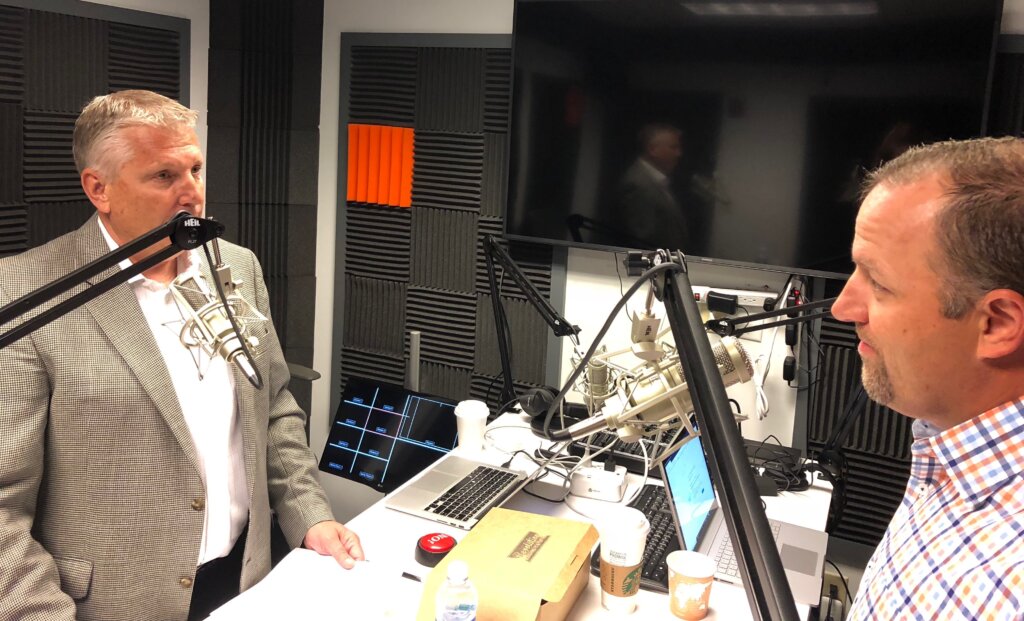Maxwell Executive Leadership Podcast #10: 5 Ways Leaders Build and Maintain Momentum

Managers can solve problems, but leaders create momentum. When you create momentum for your team, it solves 80% of your problems. Are you a momentum-building leader or a momentum-breaker? Listen to Episode 10 in our Executive Leadership Podcast to discover more.
Listen to all podcasts in this series and subscribe to new episodes on iTunes– or Google Play.
Read the transcript below:
Welcome to The John Maxwell Executive Leadership Podcast where our goal is to help you increase your level of influence, increase your reputation as a leader and increase your ability to fully engage your team to drive remarkable results. I’m Perry Holley, a certified John Maxwell, facilitator and coach, and I’m Chris Goede, Vice President of The John Maxwell Company. Welcome and thank you for joining.
Chris, today’s episode is titled “Five Ways Leaders Build and Maintain Momentum.” Now, I recognize the idea of momentum from John’s 21 Irrefutable Laws of Leadership as the law of Big Mo which states that momentum is a leader’s best friend. I know that John has a quote talking about momentum being a great exaggerator. Without it, everything is harder than it should be. And with it, everything is easier. So tell me, where does momentum come into play in successful leadership and the Five Levels?
Well, I love this question. Momentum is the big exaggerator. Before I answer that question for us, let me just remind the audience, if you want a recap of the overview of the Five Levels, please visit the first episode of our podcast series where I give an overview of the Five Levels. Back to momentum, it’s probably the most talked about topic when it comes to what we describe as Level 3 in the Five Levels of Leadership. This is the production level. We talk about this is where you’re getting results for the organization, not only individually, but you’re also getting results in and through teams. And speaking of momentum, John says that when you have momentum, it solves 80 percent of your problems.
As leaders, we should be striving to create momentum when it comes to Level 3, the production level as leaders. You need to understand that this is where your credibility is built as a leader. And what we want to make sure is that you continue to produce as a leader, but we also have a focus of beginning to drive results in and through your team as a leader.
It’s funny, when I think about it, for some of our clients that are outside the United States, I just started talking about you have to pay attention to Big Mo. Finally, some bold young man in the front row said, who is this Mo? We gotta be sure we’re clear on that. So, I agree, Level 3 for me as I was coming up in a first line leader, second line leader, really relationships at Level 2, I find that very easy. Production, producing results really is what quantifies and separates you as a leader. It really sets you up because it’s hard to fake a Level 3. You do it or not. So when you think about momentum, it’s often that I think about it watching sports on TV and the announcer says that one team or another has momentum. Everything is going their way for the moment. I’ve also heard them say that momentum has shifted and that one of the teams has really lost the momentum or one has really gained the momentum. Do you find this is really true about high producing teams, as well?
I do. I absolutely do. And I also feel like the leader has everything to do with whether the momentum is present, whether it’s not there or whether it’s growing. I’ve always felt that momentum for me was about an energy level that I had with my team. When energy lags and people disengage, momentum is lost. So tell me, for you, are there things that you’ve seen leaders do that build and maintain momentum with their team? Yeah, absolutely. The first thing that comes to mind is as a leader when you’re creating momentum. First, let me back up. One of the things I hear John say at times that sticks with me is that managers solve problems and leaders create momentum.
As leaders, we need to be thinking about making sure that we have people that are helping us manage process and things and that as leaders, we are leading people and creating momentum. But, what you have to do is, I feel like you really have to communicate and promote the vision and the vision has to be for your team in alignment with what the vision of the organization is. It has to be simple, and as a leader, I think in order to create momentum, you have to have the longest view in the room. It comes back to the belief thing that we’ve talked about in the past where as leaders, we probably believe more in people than they believe in themselves. Same thing with the viewing and communicating the vision. We need to make sure that we have the longest view in the room and that we’re casting that view and that the vision with our team again and again and again with clarity so that our team can refer back to that and have priorities around it.
I always found that this vision, as you’re speaking in the big picture, the clarity helped avoid the tendency that most people have to focus on busy work. I often think of the urgent versus the important. If I’m not clear and I don’t know the big picture, I don’t know what the priorities are and so I may focus on more urgent and less important things. Yeah, absolutely. I agree with you. Another thing you see with momentum-building leaders is the focus of their team is on doing a few things really, really well and I’m sure if you’re listening right now, you’re probably laughing and you’re like, okay, who of us can just do a few things inside the organization? It’s a challenge. We talk about it at The John Maxwell company, often. We allow our teammates to say no. We give them permission to say no to external projects, external ideas, internally, and they can communicate that to us. And what we try to do is get them to focus on what they do best.
Here’s a great little practical exercise that you could do. I would challenge you to list out and bring to you are you list out the things that you are responsible for that are on your priority list and that are taking up your time and I would challenge you to take those to your leader and have them ranked by the leader and you guys become in alignment of what they are and then agree to what your priorities are going to be because if you’re in sync there and there’s alignment there, you’re going to create momentum around that knowing that yes, you may have a list of 53 things, but those top three things are the most important to you and to your leader and that’s just another way to create momentum.
I’ve been working on recently most important things on a one on one call each week. I just want to know from each person what are your top three things? What is your most important task for this week? Just to know that I know there’ll be 100 things you could do. What are the three you will do? So I thought you were gonna ask me to bring back my no button there for a moment from the last time. You’re allowed to say, no, you can use that. But yeah. Well, I recall I’m leading a team which I consider to be a really high performing team for me, but I notice momentum was not on our side. People were distracted. There was a little bit of lag I would say going on. And when I looked into what was going on through my weekly one on ones, I found that because we were a well-known, high producing team, other teams were asking my team for help. Now, I want to be a good corporate citizen and other places where you really need to help. But I wanted my team to know or it can of we talked last time about boundaries or about the no button to really keep them focused on what are we really great at doing and where we can assist other people. I want to do that, but we have to make sure that we do our most important tasks first. Momentum to me was when we were doing the right things with clarity and vision, knowing what we were trying to accomplish and then doing those small things daily executing really built a positive flow and energy level on the team.
Well, I was listening to you and the first thing that struck me was the fact that that you acknowledged and protected your team right from yes, you wanted to be a good corporate citizen, but the same point in time you were protecting your team from that and I think in order to keep momentum, create an even keep momentum, that that is something you absolutely must do. Another thing I was thinking about around momentum is making sure, and you know we’ve talked about this in the past about having everybody in the right seat on the bus, but making sure that your team is working in their strike zone. We talk a lot about the fact that we would much rather see our team or people working in their strengths than trying to improve their weaknesses. I think I maybe even mentioned in the past, a certain child of mine with when it comes to the math score and where we’re at with that, but as a leader, you need to make sure you know what your team’s strengths are. You need to understand what they are and making sure you have them working in their strength zone.
While it used to bother me, John, I heard him say you need to 80 percent of your time on your strengths. And I was always taught, I guess coming up, you should work on your weaknesses, make your weaknesses stronger. And, this is so true. If you’re spending time on your weaknesses, you can delegate things you’re not great at, you can bring in team members that can help on that, but you need to focus on your strengths and do what only you can do. And that really helps that momentum and that focus. You know, one of the things in regards to positive momentum that I was thinking about when you mentioned that was as a leader, you need to make sure that you’re waving the flag, around change and being a change agent, but nobody likes change.
No one likes change, right? One of our other facilitators and executive coaches, Greg Kagel has taught me this saying that I use off often, which is if you don’t like change, you’re going to like irrelevance a whole lot less. And so really sustainability is all about change in your organization and we need to make sure that your department, your team, your project, as I say, is not being Netflixed right? And I say that all in regards to what Netflix did to Blockbuster. You remember what Blockbuster was. Um, and so I’m not that old. You need to be that change agent. You need to continue to focus on change in what you guys are doing. Change creates excitement, not maybe at first for some people, but it creates momentum and you need to, you need to be waving the flag for change.
Totally agree. I often found, as a young leader, I didn’t even think of myself as a change agent, didn’t cross my mind as I grew it. It occurred to me that’s my main role that if things don’t need to change, you don’t need me. That’s, and so my job is to find a way to get to where we’re going in a better way. And I think it’s easy to become too focused on a current reality. There’s so much going on around us. So many distractions, so much action, such a busy pace that we get focused on what’s currently happening and forget where it is we’re going and what needs to change to get us there. You know, one other thing I was going to think about outside of change, as we kinda wrap up here today, is that as leaders to create momentum, you need to be in decision-making mode.
There’s nothing worse than having a leader. And I even fall because I’m an analyst by trade at times to where I am, aim, aim, aim, pull the trigger, right? And the deer’s gone versus making a decision quickly in order to keep that momentum going for your team. You will be creating momentum and I would just encourage you to, no matter what the situation is, continue to make difficult decisions or even just normal decisions that you need to make quickly. Don’t delay, don’t wait, don’t ignore the issue and hope it takes care of itself. You need to make sure that you are leading the way by making decisions quickly. I think these last two points, especially about a change and decisions is really what separates and qualifies leaders at Level 3 because that’s really what gets things done. But as we wrap up, let me ask you to give our listeners maybe Chris a couple of things they should be thinking about as they want to become momentum builders and not momentum breakers for their team.
Yeah. The first thing I want to tell you is that you need to continue to produce yourself, right? We attract people like we are, not like we want. And we can unpack that on another podcast because that’s a thought that you need to think about. And, you need to make sure that you contInue to produce yourself, which helps ignite momentum. Some other things that I think about when you asked that question was how and questions that I would even ask myself. I would ask my team and here’s three of them for you. How can I help my team members be more productive? Right? What roadblocks? You mentioned earlier, it’s your job to protect them. It’s your job to remove roadblocks. Second question, what could I do to make things easier for them? That kind of falls into Level 1 there. So how can I help them be more productive?
What can I do to make things a little bit easier on them producing? And then finally around were roadblocks. What roadblocks can I assist with or move to increase their production that maybe they are aware of or even if I have the longest view in the room, as I mentioned earlier, they don’t see them yet and I’m out in front of them clearing those roadblocks. And I liked something you said right at the front there. You don’t have to think of these things all yourself. Each of those three questions I love, but I definitely have an answer, but I also ask them what would be their answer to that.
Thank you, Chris, for the great insights and thank you everyone for listening. If you have a question or if you’d like more information about the Five Levels of Leadership, perhaps bringing the Five Levels into your organization, you can go to John Maxwell company.com/podcast. We’d love to hear from you there.












Be the first to comment on "Maxwell Executive Leadership Podcast #10: 5 Ways Leaders Build and Maintain Momentum"